
1860 - 1920

Some of his most important works can be seen at Nationalmuseum (National Museum of Fine Arts) in Stockholm. Among them is Midsummer Dance (1897), a depiction of dancers in the evening light of a rural Midsummer Eve celebration. Other museums holding works by Zorn include the Musee d'Orsay in Paris and the Metropolitan Museum of Art in New York.
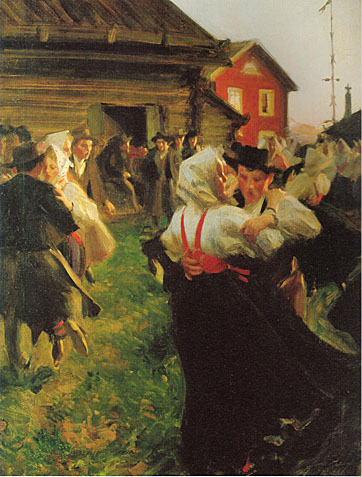
Johann Zorn met Grudd Anna while she was employed temporarily at Von Duben's recently started brewery in Uppsala, they never got married.
Anders Zorn didn't have any contact with his father.
Since Anna worked in Uppsala, Anders stayed at his grandparents' farmyard in Yvraden. In 1870 Zorn started his studying at the age of twelve in the school at Morastrand.
During the autumn of 1872 he progressed to a secondary grammar school in Enkoping. After three years he had completed his studies in: Christianity, Swedish, and German, history, geography, mathematics, natural science, calligraphy and Latin. He was not a successful student, his grades were satisfactory, but his teacher discovered that he had an artistic ability.
Later that year, on Boxing Day, his father died in Helsinki and Anders inherited some small funds for his further education.
On January 3 1874, Zorn's mother married Skeri Anders Andersson and moved in with him to Skerigarden in Lisselby (Mora). During that winter Anders Zorn had the opportunity to show his woodcarvings to Ahlborn the woodsculptor in Uppsala.
He was confirmed in the church in Enkoping on June 14.
On July 15 the distribution of the personal estate of brewer Leonardsson was read in which 3000 SEK was set aside for Zorn's upbringing. Anders parental guardian was a farmer in Mora, Balter Sven Ersson, who on December 12th received the funds from the County administration, this money lasted for four years.
On November 28 Anders Zorn's half- sister Karin was born.
From 1875 to 1881, Zorn studied in Stockholm at the school for Handicraft and later at the Royal Academy of Fine Art's preparatory school, the so- called Principle school, (start 18th Sept. 1875). He studied, among other things, painting, drawing and sculpturing.
Zorn lived poorly and had to struggle against poverty. He soon earned himself a reputation as a drawer and painter in watercolor. During these years, Anders lived a double life; one in Stockholm among the fine gentlemen during the winter and a peasant life in the summertime in Dalecarlia.
As a student Zorn had the opportunity to visit the memorial exhibition of Egron Lundgren (500 paintings), arranged by the Royal Academy of Fine Art during April and May 1876. At the National museum, the painting Jaktnymf by Julius Kronberg made a deep impression on the young Zorn.
He spent the summer months in Mora and Orsa that year. Zorn was now working on watercolor paintings on the theme Raking, Kulla som rafsar.
Anders grandfather dies on December 23, at Uppsala Academic Hospital.
In the spring 1878, he stayed in Mora and Skattungbyn (Dalecarlia). In July Anders, together with friends Hjalmar Falk and Olof Grafstrom travelled to Halsingland and Medelpad (province).
Anders received a diploma at the Royal Academy of Fine Art in August 28, and he moved up to The antique school in the autumn. Among his new friends were Richard Berg, Oscar Bjork and Robert Thegerstrom.
His inherited funds had come to an end, but his father's German friends had a collection for his benefit.
In 1879 he passed his studies at the Royal Academy of Fine Art. The subjects were perspective (passed 10 April), anatomy (passed 2 May) and the School of sculpture he completed on May 13. He received his diploma on the 28 of June.
In the spring of 1880, Zorn had gained himself a name as a painter. The academy had its yearly Student Exhibition and Anders presented the watercolor, In Mourning at the exhibit. The painting's motif is of a beautiful young woman attired in mourning. In the Official Swedish Government Gazette of May 22 the painting was praised by Carl Rupert Nyholm a prominent Swedish critic and Zorn later was rewarded with 200 SEK for his work of art.
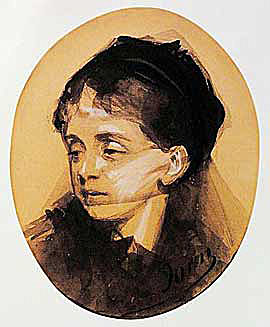
Anders moved to a studio at Hamngatsbacken in the autumn of 1880 (Stockholm).
In the spring of 1881, Anders Zorn met Emma Lamm and on June 2, they were secretly engaged. Emma came from a respected Jewish family and she was interested in culture. Her deceased father Martin Oscar Lamm (1824-1878) had run the S.L. Lamm & Son Textile Company. Her mother's name was Henriette Lamm. Emma lived in Stockholm during the winters and during the summers she and her family (she had two siblings Herman and Anna) moved to Dalaro in the archipelago.
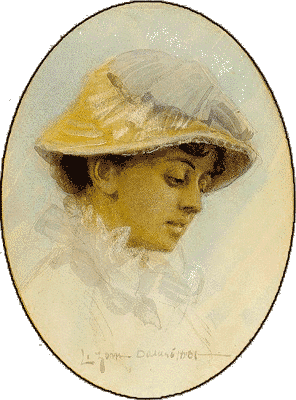
This year he left Sweden for the first time and in August he had settled down in London. The first years Zorn only painted watercolors but still managed to acquire a reputation in England.
During the autumn and the winter Zorn travelled together with Ernest Josephson to Spain via Paris where they visited Madrid, Toledo and Seville. They continued their trip and on New Year's Eve they were in Cadiz.
In the beginning of 1882 Zorn participated in an exhibition in Cadiz and was praised in the El Comercio. On February 26 he wrote to Christian Bolinder and told him that he would send the paintings Kusinerna and Modersgladje to the exhibition in London.
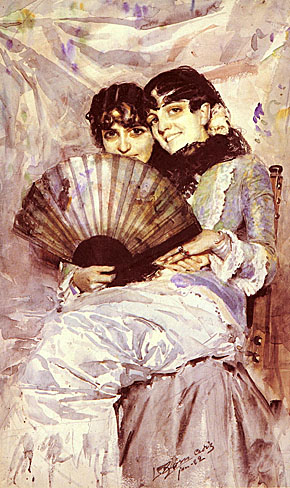

Zorn wrote a letter to Georg Nordensvan about his love for his native country and about his admiration for Egron Lundgren. Then he continued from Italy to Paris where he met Emma and her mother. He told Ernst Beckman in a letter that he: enjoyed enormously all the art he has seen.
Anders spent the summer together with Christian Bolinder in Richmond, England, where he depicted views from the Thames. Throughout the autumn, he stayed in London at 42 Brook Street. Anders was together with Edward Casparsson, who later acquired Modersgladje for 50 pounds. In the late winter Zorn and Casparsson visited the gallery at Rue de Seze in Paris where he encountered Sargent's Paintings.
The first half of 1883 Anders lived in London and on February 22 he wrote to Casparsson and told him that he would etch a portrait in copper for his publisher Axel Herman Hagg. It was through Hagg that he encountered the basics of etching techniques.
He sold his painting Italienska Gatumusikanter for the sum of 27 pounds.
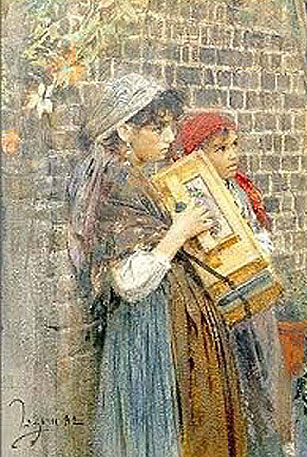
Zorn made at these time preparations for the watercolor Lady's Man, and on October, Anders worked in Julius Kornberg's studio in Stockholm and in the beginning of November, he met his friends Josephson and Forstenberg in Gothenburg.
Back in London Anders moved into an apartment in Cavendish Buildings and Emma wrote from Stockholm on November 13th that: all our siblings now know that we are engaged.
Zorn spent the beginning of the 1884 at Clovelly in Devon, where he was with the Bolinder brothers. After that he returned to London and in the spring, Anders travelled from London to Lisbon. On this trip he signed the portrait of Mr. Benjamin. Then he proceeded to Madrid where he started his big project Karleksnymf and Zorn was an exhibitor at the Exposion general de bellas artes.
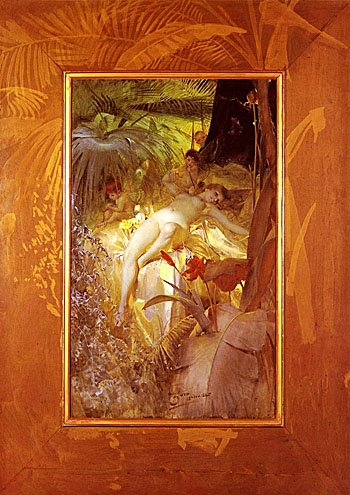
Anders returned to London in the early summer and towards the end of August, he made a quick visit to Paris and met his brother- in- law Herman Lamm.
In January 1885, Anders was allowed into The British Museum's graphic collection and on the 29th he received the letter that his half- sister wrote from Mora, saying that little Kersti died the 10 of January.
In the spring of Zorn made a couple of trips to Paris. In London, he did the portrait of the art dealer Robert Dunthorne and of the American Clarence Baker. Now he finished what he had started in Spain, his project Karleksnymf.
The engagement between Anders Zorn and Emma Lamm was announced and Emma and her mother Henriette were introduced to Zorn's relatives. The newly engaged couple spent the summer on Dalaro.
Zorn's stepfather Skeri Anders Andersson died on June the 15.
In the beginning of September, Anders painted Fru Jeanna Aspelin and Brukspatron Chr. Aspelin when he stayed in Fagersta. For the first time he met Ernest Cassel during a dinner at Consul- general Henrik Davidson.

On December the 1st Anders Zorn was appointed to a Knight, and the Royal Academy of Fine Art awarded him the Egron Lundgrenska medallion for water coloring.
The journey continued well in to 1886 and on January at Konstantinopel he signed the paintings, Kaikroddare, Stambul, Sovande Odalisk and I Top Capu. Shortly thereafter Zorn became seriously ill with typhoid fever and was near death. When Anders finally improved from the illness, they continued with the steamer Aurora to Athens where they met the naval engineer Von Eckermann.

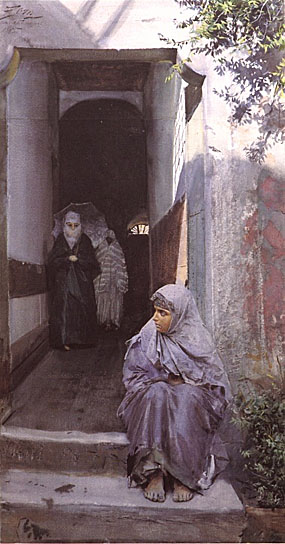
In the beginning of the summer, the Zorn's arrived to Dalaro and during July and August; Anders produces the paintings En Siren, Kapprodd and The Thornbush.
On August 16 Anders showed three paintings in The Gothenburg Exhibition and two days later the opponents (the artist who was opposed the Royal Academy of Fine Art's way of seeing thing's) gathered in Zorn's doublet at Hotel Kristiania to constitute a society- the Artists Associations.
During that autumn he purchased a lot of land adjacent to Mora church from his mother- in- law Hox Anna Persdotter. Zorn started to work on his painting Our Daily Bread, that he showed together with six other watercolors in the Artists Associations Exhibition in Stockholm on October 8. Twelve days later Zorn approved the publishing of his biography in the periodical Forr och Nu (Now and Then) to the editor B. Wadstrom.
In February 1887 Anders and Emma were in Algeria where he worked together with Bob Thegerstrom and he produced the paintings I Algers Hamn, Ouled Naid and Daiduscha.
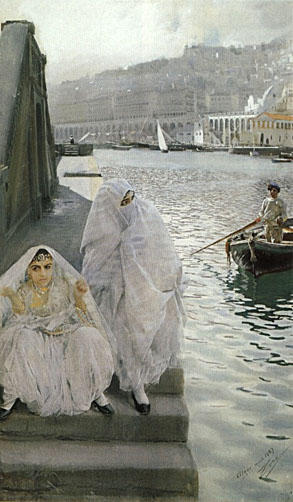
Zorn was in Dalaro that summer and now he painted the big watercolor Vagskvalp. He now started to improve a genre that would have a significant part on his artistry: nude in nature. Emma's relative, Jacques Lamm, bought the watercolor paintings Sommar and Studier i olja and these paintings document very well Anders first attempt in this genre.
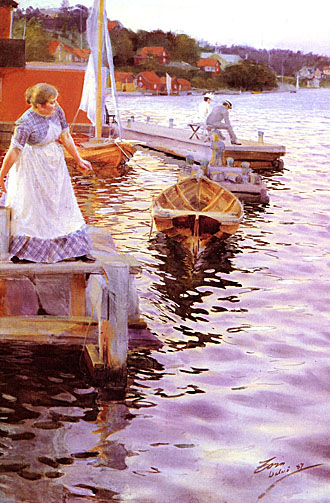
In the autumn he displayed his watercolor Vagskvalp in the Artists Associations exhibition in Gothenburg and the public and critics were amazed.
In the late autumn Zorn was in England and he did two portraits on assignment by Cassel, Mrs Symons depicted in Scottish environment and the other portrait was of Anna Jenkins.
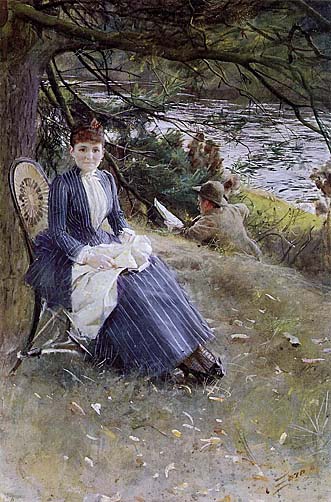

In the beginning of 1888 in St. Ives, Zorn made the meter high watercolor Fiskmarknad i St. Ives.

Anders contributed actively, during this time, to the opponents campaign against the Royal Academy of Fine Art.
The summer Anders spent on Dalarö where he worked on the paintings Ute and Une Premiere. He arranged together with Mr. Perseus the Artists Associations autumn Exhibition, opening September 12, on Blanchs Art Gallery (Stockholm).


After a shorter visit in Mora, Anders and Emma travelled to Paris and he made two important paintings there: The portrait in watercolor of Rosita Mauri and the portrait in oil of Antonin Proust. Christmas was celebrated at Woodlands with Charles Armitage.


His work was exhibited in Paris and the paintings were very successful and at the World Fair and Art Exhibition he was rewarded with the First Class Medallion for his big watercolor Une Premiere. His collections were impressive.
At the Art Gallery, he received the Third Class Medallion for Ute. Zorn was much appreciated by the critics and the public, but there were reservations, not at least among his fellow compatriots, of an ethical kind. He appeared to be too competent.
The summer of 1889 he was in Mora and on Dalaro. The 12th of August Thegerstrom was saying that Zorn: sails out twice a day with his nude Miss from the inn.
The Zorn Manor was now completed in its first shape. During August, Zorn had an order on two paintings with Dalecarlia motif. Anders made Baking Bread and Kyrkfard as a result of the art collector Robert Dunthorne's order. During this summer he also made Badande med parasol.
On the 3 of December Zorn was appointed Chevalier de l'Ordre National de la Legion d'Honneur. Towards the end of that year he went to England and visited C. Armitage, and he did a portrait of the host.

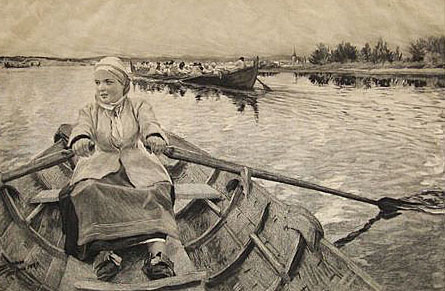
The years in Paris 1888-96 made him internationally well known. He met that times great painters and sculptors. Zorn was very outgoing and had it easy to get in contact with people and he showed familiarity with the ways of the world.
Later that spring Anders participated at an Art Exhibition on Blanch's Art Gallery in Stockholm. During the summer he made a trip to the Nordkap (Norway) where he dedicated Nordkap i midnattssol to Mrs. Rikoff.
In the autumn in Stockholm, the city's embankments and watercourses was getting Zorn's attention, among others the big oil painting Utsikt fran Skeppsholmskajen and the watercolor of the American warship Baltimore which on the 14 of September anchored at Stockholm's strom, bringing the remains of John Ericsson. By October Zorn was back in Mora and during that time he made watercolors suit the fair at Mora. Back in Stockholm later that autumn, he did a series of oil paintings with motif from breweries. Towards the end of October, he participated in the Artists Associations Exhibition with a small, but qualitative collection of paintings from Lofoten (Norway) and Mora.
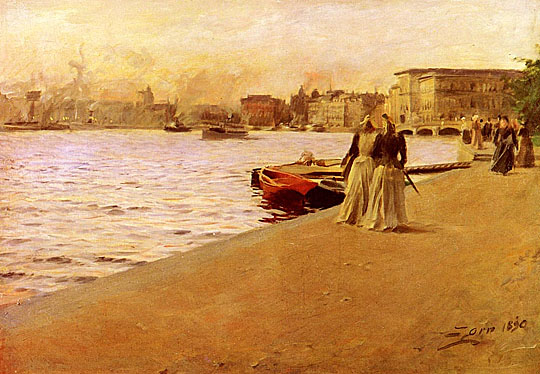



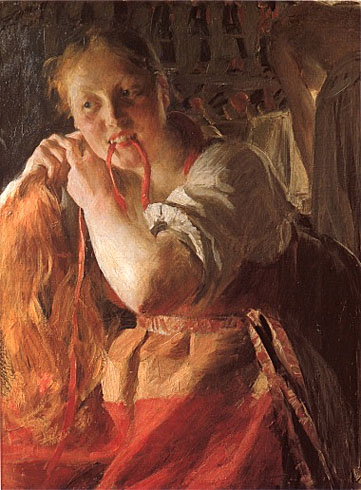

Zorn's big project in the late winter of 1892 was Omnibus and it was well received during that year's exhibit. During the spring he participated in a big Graphic Art Exhibition, organized by Durand-Ruel where he appeared with one of his mayor work in graphic art, Renan.
In the late summer, Nils Edward Hammarstedt superintendent of the Nordic Museum (Stockholm) visited Anders in the Zorn Manor. He now started to paint The Fair at Mora on a larger canvas.
During the autumn Zorn stayed in Stockholm preparing for The Chicago World Fair and he produced En skal i Idun. The 27 of December he and Emma travelled to Paris.
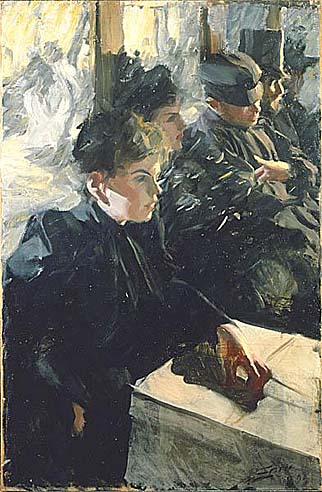

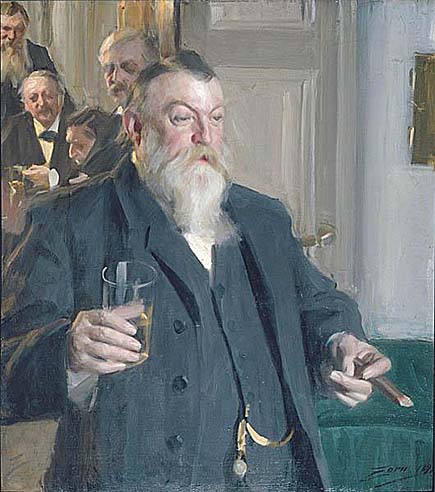
Anders now met Isabella Stewart Gardner, who he would spend a lot of time with during the following years. He stayed for more than a year in America, and most of that time he did portraits on order.
Zorn was a person liked by the Americans and he made a lot of friends and patrons among the wealthy public. Through the year he did a whole gallery of prominent American men and women from the days when America became a superpower and it was at this time he made most of his fortune.
In September he worked on a portrait of Mrs. Potter Palmer, ordered by the chairwoman of the American Women's Association for the World's Fair for the sum of 3,000 dollars and after that towards the end of the year Zorn returned to New York. Zorn celebrated his birthday 1894 in Boston at Mrs. Gardner's as a guest. In New York, the whole Swedish collection from the Chicago World fair was exhibited under supervision by The Society of American Artist. His paintings, Mrs. Potter Palmer, Mr. Thomas Wheeler and En skal i idun occupied an essential part of the exhibition.

After a short visit in Mora, he spent the summer on Dalaro together with Christian Eriksson. The working speed was high and he did a couple of paintings: Femme au jupon rouge, Solnedgang, Skargard, Frileuse, Sommarafton, variations of Une premiere and Efter badet.


Throughout the autumn Mr. and Mrs. Zorn travelled to Venice after an invitation from Mrs. Gardner and made a stopover in Wurzburg. The 22nd of October Zorn completed the Portrait of Mrs. Gardner. After a tour in Italy, the Zorn's returned to Paris in the beginning of December.
In the spring 1895 Zorn was in Paris where he was working on Natteffekt. On May 15th, he was awarded the Order of the Northern Pole Star for his work as Commissioner at the Chicago World Exhibit.
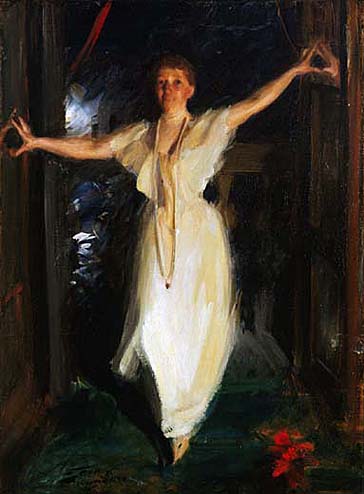
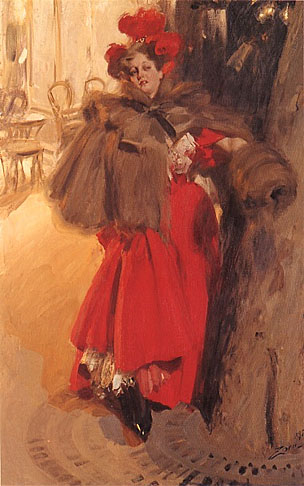
The summer Zorn spent at Dalaro and the 6th of July Zorn and his friend Ralph Curtis made a voyage on the Baltic Sea with Zorn's boat the Mejt. He continued to work on his old motif Une Premiere and during this summer, he finished a painted ceiling for Carl Robert Lamm in Nasby Mansion north of Stockholm.
After a quick stop in Mora (September), he returned to Stockholm in November where Emma had an operation and rested at her mother's place.
Zorn visited Gothenburg and started the preparations for the etching of Makarna Furstenberg. After that he went to Paris and in a letter to C A Ossbach on the 18th of December Zorn viewed his opinion on how to organise the work of judging at the Stockholm Fair of 1897. He also expressed his happiness that Von Rosen and Cederstrom resumed their work on the committee.
Towards the end of December, Zorn met up with Whistler in London, to be assured about his participation in the Stockholm Fair.
In the beginning of 1896, Zorn stayed at Woodlands where he continued his work on Faun och Nymf, after that he went to Paris. He now finished his Sjalvportratt med model, which was exhibited in the Gallery during the spring.

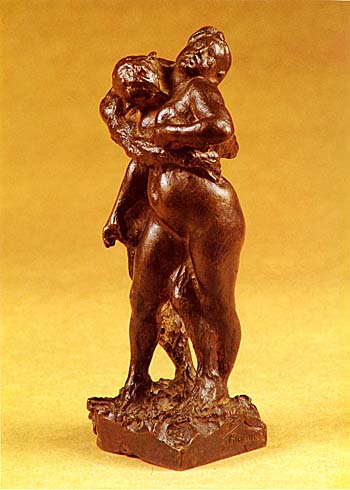
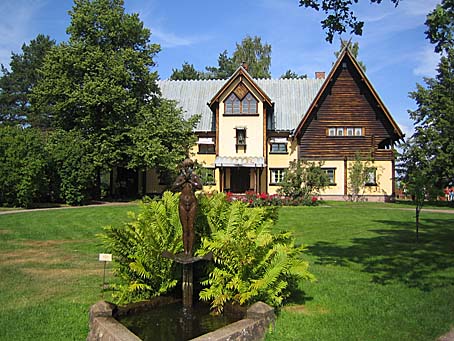
On June 30th Zorn was informed by the Ministry for Foreign Affairs that Umberto had appointed him to Officer of the Royal Italian Order.
Well back in Paris in the autumn, Zorn painted a portrait of the Russian railway magnate S. I Mamontov, at the same time Zorn's painting Natteffekt made a success at the Berlin exhibit. During late autumn, he began his second trip to America and in St. Louis; he painted portraits of Dr Taussig, Mr. Adolphus Busch, Mrs. Busch, Mrs. Duncan Joy and Mrs. Nugent.
In the beginning of 1897 Zorn was in New York and painted a portrait of E R Bacon and his sister- in- law Mrs. Walter Bacon.

Zorn returned to Stockholm during April and on the 15th of May opened the Stockholm Fair and he was a member in the B-jury that had to judge the 317 works of art.
The Zorn Manor's extension was completed during the summer and Zorn was absorbed by his work on Midsummer Dance, the paint was probably still wet when it was transported to the ongoing exhibit in Stockholm.
In the middle of July Sergej Djagilev visited the Zorn Manor and later, in his introduction to the Scandinavian exhibition in St. Petersburg, he reported about his visit at the Zorn Manor.
When Midsummer Dance was displayed at the Stockholm exhibit during September, Zorn gave permission that his painting could be reproduced to the benefit of the building foundation of Stockholm nation.
The 11 of October Zorn was appointed as a member of The Royal Academy of Fine Art in Copenhagen.
Zorn was represented with eight oil paintings at the Scandinavian Exhibit in St. Petersburg. He was in Russia as a guest at Djagilves on the 4th of November and later he started to paint a portrait of Princess Tenisheva. That portrait was never finished. Zorn had a headache. Later he insinuated that the Princesses was lesbian and that had been the obstacle. Zorn and Djagilves travelled to Moscow and the programs were intense and filled with activities. He finally returned home and spent his Christmas in Mora.
Most of 1898 Zorn was in Mora but during a visit to Stockholm he painted a portrait of Prince Carl and later during that year he also painted a portrait of his Mother in the Zorn Manor.

In the beginning of December Zorn was heading towards Paris, and in late December, he started his third trip to America. He arrived in New York shortly before Christmas with the steamer Teutonic together with Edward Bacon and shortly after his arrival in the city, he visited Isabella Steward Gardner.
Zorn spent the spring (1899) and the early part of summer in America, working very hard and he felt he kept a working tempo that was high and he considered that he did not have time to go outside his own doorstep. At the turn of the year he did alteration on his painting of Mrs. Bacon, he etched Keppel and prepared a trip to Mrs. Gardner in Boston. During his stay in Boston, Zorn painted four portraits: George Peabody Gardner, George Monks, Randolph Coolidge and John Chipman Gray.
At that time in April Zorn travelled around in America and visiting among others places, Princeton, St. Louis, New York, Chicago, Boston and Evanston. In this connection he painted numerous new portraits: the former President Grover Cleveland and his wife Frances Folsom Cleveland, Daniel Burnham, William Amory Gardner, Miss Martha Dana and Mr. Saltonstall.
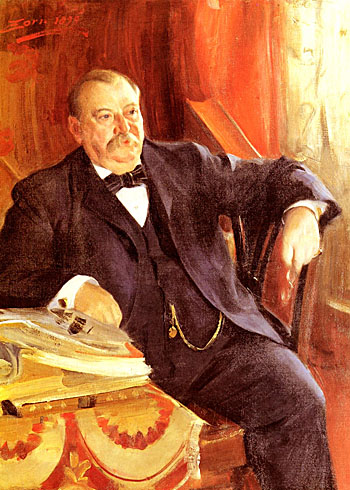
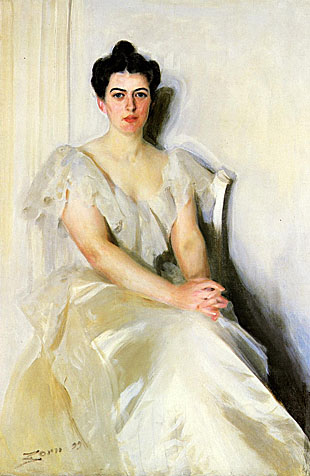
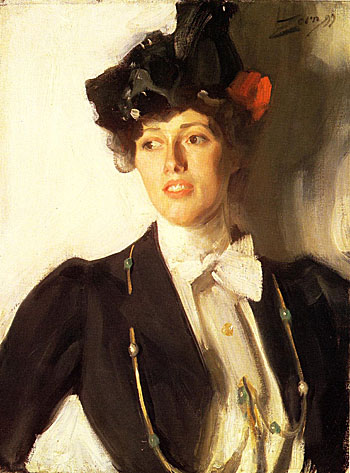
In the beginning of the summer Zorn returned to Sweden, and for a short time, he was sick and stayed at Hotel Rydberg in Stockholm.
Emma had during the winter (when Zorn was in America) been very active in her social life and kept an eye on Zorn's interests for the upcoming of the Artists Associations at the Helsinki Fair.
This summer Verner Von Heidenstam visited the Zorn Manor and Zorn was again contacted about the planned statue of Gustav Vasa in Mora. His original proposal of the statue, a model in clay, was to be seen during the autumn in the Zorn Manor. In January 1900 he stayed in Mora equipping his studio and did two versions of Madonna. In the middle of March, Zorn arrived at Paris as the commissioner for the Swedish Art Division at the World exhibit. During his time in Paris, he made a trip to Spain and visited Madrid and Barcelona. Towards the end of July, the press announced that Zorn had been rewarded with the Medaille d'honneur, the votes in favor were 46 out of 53.
Back in Mora during late summer Zorn expressed himself in a report about his native home interest, uttered his disappointment over the town plan in this small community, that it had been vandalized to a chessboard shape and that the restoration of Mora church lacked reverence.
Zorn made a stopover at Hugo Reisinger an Art collector and entrepreneur in Berlin and continued to Paris where he worked for a couple of weeks on the portrait of Mrs. Cameron. At the same time, he prepared for the statue of Gustav Vasa. In a letter to Emma, Zorn wrote that he received an estimate of 10.000 francs for the enlarging and casting of the three-meter statue, but then he had to have a meter high model of plaster.
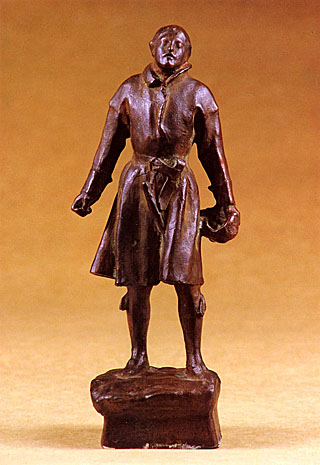
In the beginning of 1901, Zorn was an exhibitor at Durand-Ruel in New York. The collections were mostly portraits, nude studies and Omnibus. Emma returned to Sweden and Anders wrote her a letter saying he missed her.
On April 24th Zorn received Die Grosse Goldene Plakette at the international Art Exhibition in Dresden.
The dispute about the payment for the portraits of Mr. Pierce, Mrs. Pierce and Mrs. Eben Richards (Pierces daughter) back in 1899 had for Zorn a successful conclusion. The invoice of 13,200 dollars had been paid.
Zorn came back to Sweden just in time for the summer and he made a voyage with his new boat Mejt I, named after his half- sister, then back to Mora where he stayed the rest of the year. He was anxious about finishing his work on the statue of Gustav Vasa and Emma wrote to Elin Thegerstrom (Dec. 10) that he is working twelve hours a day.
In the early winter of 1902 in Mora Prince Eugene who celebrated Zorn on his birthday visited Anders. On this occasion, The Prince gave his hosts three paintings that were depicting the province of Mora; Zorn presented on his part the oil painting Kuver Maja to the Prince.
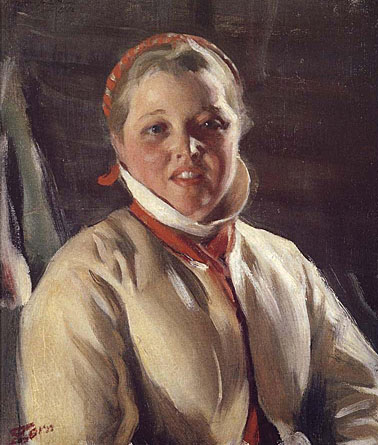
Zorn celebrated midsummer in Mora and started his voyage together with J.A.G. Acke abroad on Mejt I (11th of July), they had reached the Kalmarsund and the sailing trip continued to Simrishamn, Helsinborg, Varberg and Saro.
Later that autumn Zorn rented a studio at the corner of Drottninggatan and Bryggargatan in Stockholm and during Christmas, he was in Mora together with Stenhammar at the Zorn Manor. It was now that Stenhammar got his idea for the rhapsody Midwinter.
In February 1903, Zorn announced that he would leave the Artists Associations and on the 7th of the same month he became an honorable member of the Vastmanland- Dalanation.
Together with Prince Eugene they were exhibitors at the Art society and the critics became attached to Zorn's freshly depicted native home motif, as was expressed in the painting Braskulla, there was also a sketch of the Gustav Vasa statue.
In the end of March he started his trip to Eastern Europe and made a stopover in Berlin where he dined with Liberman, Leistikow and Cassier before he continued to Danzig. The 3rd of April the Swedish National Museum decided to buy Zorn's Midsummer Dance, for 10,000 SEK.
In Warsaw, he visited the Jewish neighborhood and the horse market; he proceeded to Krakow where he was on the 14th of April. Next stop was Vienna, where he attended the Art museum but he was disturbed by the crowdedness of the paintings.
Towards the end of April he arrived at Budapest, where he heard that his Madonna would be exhibited, this later occurred.
In the beginning of May he was in Venice, where he was a guest at the prominent art specialist and superintendent for The Berlin National Museum, Hugo Von Tschudi. The journey continued north via Munich to Paris.
On the 11th of July, at the same day Zorn was appointed Knight Commander of the Northern Polar Star Order second class, the statue of Gustav Vasa in Mora was inaugurated. He purchased the Risaloftet and moved it to the Zorn Manor. The Risaloftet was placed in connection to the other log cabin (from Fasas) that had been adapted as a studio.
Zorn was an exhibitor in the Artists Associations summer exhibit in Helsinborg. During the summer of 1903 he made a voyage with Mejt and on August 2 he was invited to dinner at Oscar II in Drottningholms Slott (Stockholm).
Later in the year he was an exhibitor at the Artists Associations Grand exhibit at Charlottenborg where Zorn showed the portraits of Prince Carl and Mother among others, but the critic Viggo Stuckenberg wrote less pleasing things about Zorn. On the 17th of November, Zorn arrived at New York for the fifth time; he left immediately for Boston to Isabella Stewart Gardner. Her new Art mansion, Fenway Court was completed and it made a great impression on Zorn. During Christmas at the Deering's in Chicago, he painted the portraits of James Deering and Charles Deering.

In March Zorn made a trip westwards over the Rocky Mountains and Sierra Nevada. In a letter to Emma he expressed, that nothing has made such an impression on me, grandiose and charming after his arrival at San Francisco. In Pasadena, Zorn painted a portrait of the inventor and industrial leader R T Cane and his wife Emily Crane.
In April, Zorn was in Evanston and Painted Richard F Howe and Senator Mark Hanna and Mr. Brookings.
On the 14th of March Zorn became a member of Konigliche Akademie der Kunste and at the end of March he returned to Sweden.
In the summer, Zorn made a voyage on Mejt I together with his childhood friend Gustaf Bolinder and they passed by Marsstrand, Simrishamn and in the early days of August they arrived at Kalmar.
The construction of the Wilderness studio in Gopsmor started in 1904 and was completed the following year.
During May Anders journeyed through Europe and passed through Innsbruck and Munich and reached Paris in the end of the month.
After the celebration of the Midsummer Eve in Mora, Zorn and Albert Engstrom made a voyage on his sailing yatch Mejt I to Finland and Estonia. During this voyage eastward they met Albert Edefelt, Emil Wikstrom, Eliel Saarinen and Bertel Gripenberg, towards the end the of the sailing tour they visited Axel Gallen at Tyreso in the Stockholm's archipelago.
Zorn had a new fishing cabin in Gopsmor just outside Mora where he spent a lot of time during the autumn. With him were Mejt and Mona and they were fishing in Garberg and Emma came for a shorter visit.
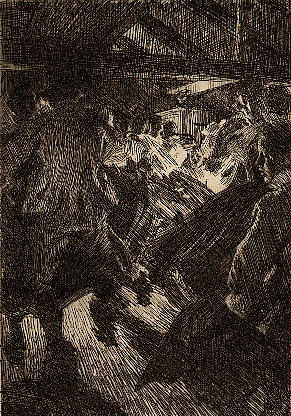

The winter of 1906 Anders spent in Gopsmor and Karlfelt visited him in the idyllic atmosphere of the wilderness. The 19th of March Zorn became a fellow of the Accademia fiorentina delle Atri del disengo.
On the last days of March Zorn left for Stockholm and Paris.
Between May 17 to June 16 Zorn was an exhibitor in a retrospective exhibit at Durand-Ruel in Paris. He showed 166 exhibits, watercolors, oil paintings, etches and sculptures. During this visit he did a series of etchings depicting the French leading personalities in the field of culture; Anatole France, Destournelles De Constant, Marcellin Berthelot, Rodin and Alfred Beurdeley.
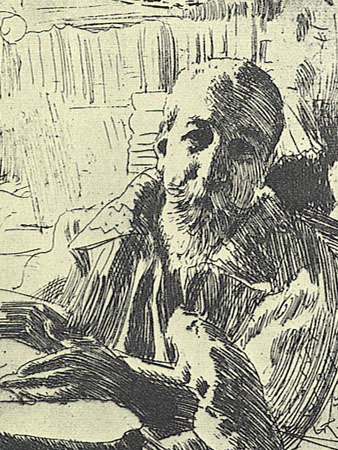

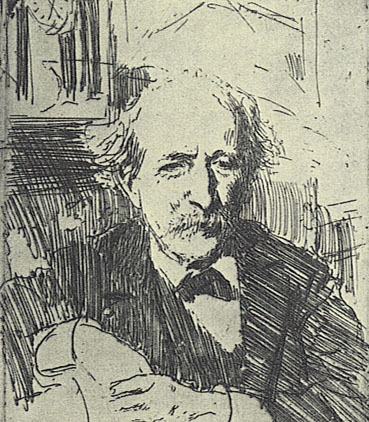
Zorn arranged a one- man exhibition in Mora courthouse later that summer. The exhibit served one major purpose, for the benefit of culture and the proceeds of the exhibition was donated for local adult education.
The 1st of September Zorn visited the folk musician festival (spelmansstamma) in Gesunda.
Then he went to Stockholm to be an exhibitor in a retrospective exhibit arranged by the Art Society in aid of the prospective folk high school (folkhogskola) in Mora.
An exhibit of Zorn's art works was arranged for Later that autumn in Uppsala entitled Oldish and Newish (Gammalt och Nytt). Some of the exposed art works in Stockholm and Uppsala were later exhibited in Helsinki.
On November 6 Zorn's half- sister Karin died of double pneumonia.
In December, Zorn returned to Mora and he wrote a letter of thanks to Saint-Gaudens who had given him a bronze bust.
He now completed his fishing cabin in Gopsmor.
The winter of 1907 he spent in Gopsmor and at the beginning of January, Anders and Mejt gave away the prizes in the traditionally trotting race at Saxviken in Mora.
In the end of March, Zorn started his trip to South America for recreation. His journey continued to Havana via Miami and then to Vera Cruz in Mexico after a short visit in New York, where Zorn experienced an earthquake. Then his travel continued to San Antonio, New Orleans and finally St. Louis.
During May he started his trip towards home on the boat Kaiserin Auguste Victoria (Hamburg America Line). Upon his arrival in London Zorn interrupted his fasting of working on a portrait of Ernest Cassel.

During this summer an Art exhibition was arranged in Mora courthouse with art works of Zorn, Prince Eugene and Carl Larsson. The purpose was again for the benefit of the culture in Mora.
Zorn depicted the countryside and its people in his most popular paintings and therefore nourished the old conception of Dalecarlia as the Swedish image. More than ever, Zorn was managing to make a local Dalecarlian culture to a National concern. He and Emma were participating actively in the local culture by supporting and encouraging the domestic handicraft and enhance the adult education through the foundation of the Mora Folkhogskola (Mora folk high school), inaugurated on the 1st of November 1907.
At the same time, Zorn started his career as a collector of, both the old relics of folk art and the international art that he bought in the European art galleries and brought home from his trips.
Mora Folkhogskola opened January 7, 1908 and Emma was reading aloud from Heidenstam's book Ett folk, but Zorn spent most of his time at Gopsmor in January and it was now that he painted In the Cookhouse.

In June, he was back in Mora and the painting Vardrommar was made at Klubbholmen in Siljan (lake).
This year the Zorn Manor got its final shape through the building of the third floor. In July Anders, Emma and Mejt made a shorter sailing tour to Kalmarsund where Emma and Mejt departed, and they were reunited in Stockholm later.
In August the Princessial couple Troubetskoy was in Mora as Zorn's guests.
On December 1st, there was a celebration at the Mora Folkhogskola and Emma was reading aloud Heidenstam's poems, even Zorn participated in the games. Christmas was celebrated in the Zorn Manor with the Sparre family as guests.
During the winter of 1909 Zorn was occupied with the portrait of Queen Sophia and in February the freshly painted portraits of Gustav V and the queen dowager were exhibited on the Swedish National Museum, together with the portrait of Oscar II from 1898.
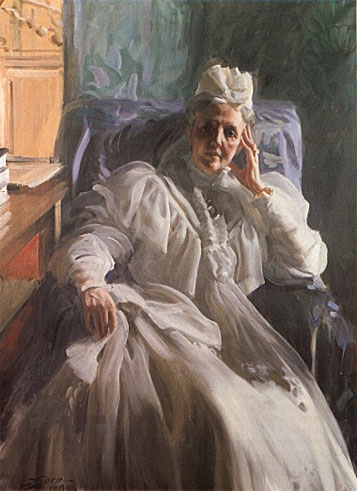
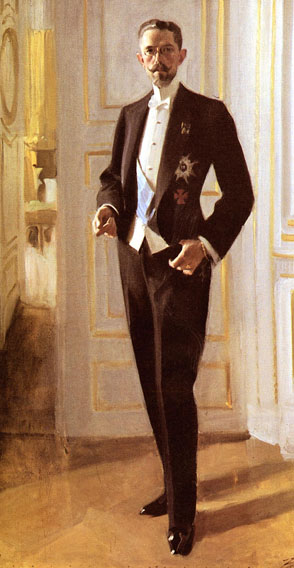
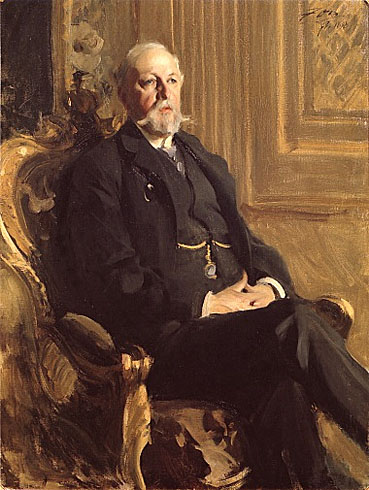
Later that spring Anders and Emma were in Venice and he was exhibitor in Biennalen with a one- man exhibition. Then they went to the Internationale Kunstsusstellung in Munich and received on June 6th, a Medallion of the first class for his painting Erwachen.
Together With Prince Eugene, the Zorn's made a car trip through Germany, Austria and Prague. From there they continued to Paris and ended the trip in London via Amsterdam.
Zorn's Morgonbad that was showed at the exhibition in Venice was installed in June in the Zorn Manor's garden.

During this year the Delteils catalogue with Zorn's etchings was published.
Zorn spent most of the first part of 1910 in his cabin at Gopsmor, but he had to return to Mora, because he did not feel well.
Vittorio Emanuelle appointed Zorn on the 15th of January as Commendatore dell'Ordine dei Santi Maurizio e Lazzaro and on the 21st of March it was confirmed that Zorn was an honorable member of R. Accademia di Belle Arti in Milano.
On Zorn's 50th anniversary, his birthday guests were Prince Eugene, Carl Larsson, and county governor of Mora Holmqvist and Karlfelt.
During April in Berlin, the Secession opened where Zorn participated with a big collection and he was unanimous praised by the press.
In the beginning of the summer, the Zorn Manor had its new veranda at northwest made and completed and Mejt visited it for the first time on the 19th of May. During Midsummer, Zorn was visited by Prince Eugene and Karlfelt and after that Zorn and the Prince went back to Stockholm by car.
In July Zorn began his usually summer sailing but he interrupted the trip in August; instead he went to Stockholm and painted a portrait of the American ambassador in Berlin, David Jayne Hill. The portrait was temporary exhibited in the Swedish National Museum.
Zorn was in Mora with Axel Munthe and wife as guests in September. Anders and Emma made a short trip to Stockholm for the celebration of Henriette Lamm's 80th birthday.
During October, Zorn was giving lessons in drawing at Mora Folkhogskola and on 16th, they celebrated their wedding anniversary.
In November, Zorn completed his etching of Strindberg and at Waldemarsudde (Stockholm), he was occupied with the painting of Prince Eugene. Zorn's proposal for an equestrian statue of Engelbrekt as a National monument to be placed in front of Parliament was given great publicity.
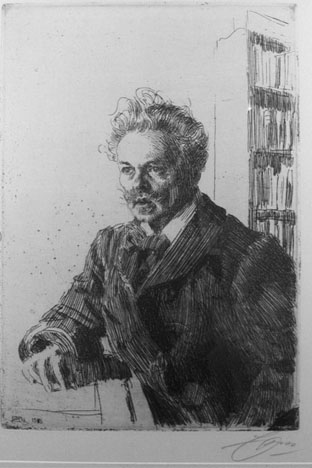

Zorn left for Berlin in the end of January together with Laurin and reported home to Emma that: the cleaning of Gustav Vasa went well but I am not done yet, he also wrote that he felt comparatively well, but it hurts when I walk a lot.
On the 13th of March, Zorn was aboard the express steamer George Washington on the Atlantic Ocean and he was busy with his autobiography, this was Zorn's seventh and last trip to America.
In Pittsburgh, he was a judge and in Washington, he did the portraits of President Taft, Vice President Sherman, Senator Aldrich, Andrew Carnegie and Mr. Piatt Andrew.

The large International Exhibit opened in Rome on the 28th of March and Zorn exhibited 18 oil paintings, 20 big etches and four sculptures. Back in Berlin, Zorn painted a portrait of Siegmund Aschott. He reported later to Emma that the portrait of Hill and the manager for the Deutsche Bank Arnold Von Gwinner were complete and had been received with exceptional enthusiasm.
On the 29th of March, Zorn arrived at Stockholm with the morning train from Berlin and Emma and Mejt met him. The following day they went to Grona Lund (amusement park) and to a dinner at Laurin's.
On June 4h, the Zorn's took the new sailboat Mejt II for a shorter test and on the 6th Mejt were aboard for a short voyage to Tralhavet where they saw the American warships.
Towards the end of June Zorn was in Gopsmor and on the Midsummer's Eve he and Mejt went to Selback (Mora), to visit their mother, and on 27th Zorn left Mora for his annual summer sailing.
In the last days of September, Emma travelled to Stockholm to visit her mother, she had received a message that her mother was ill and shortly thereafter, Zorn arrived. In early October Henriette Lamm died and the Zorn's returned to Mora after the funeral arrangements the 12th.
During the last part of the year, Zorn taught Nyman, Kusel and Riger in how to etch and Zorn also held classes in drawing at Mora folkhogskola.
He celebrated Christmas at the Zorn Manor.
On March 27 1912, Zorn travelled to the Mediterranean Sea via Munich. In Rome he met Ossbach and on Capri he visited Munthe. On his trip to Egypt and Palestine, he resumed his autobiography and towards the end of April, he visited all of Jerusalem's sanctuaries. Zorn had during his time here also been able to meet up with his fellow compatriots from Nas in Dalecarlia, who earlier had emigrated from Sweden.
During the autumn, the Artist's Association had arranged an exhibition of Zorn's artwork and Zorn was praised in the Swedish newspaper Svenska Dagbladet of the 1st of October.
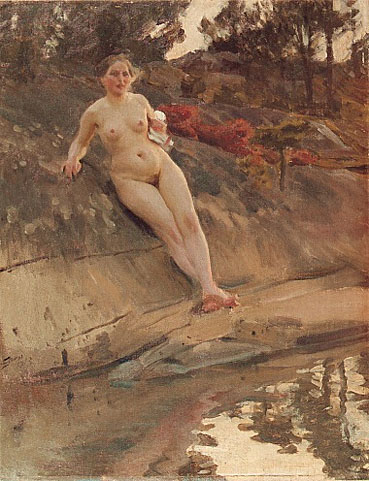
In the spring of 1913, the Zorn's again travelled to the Mediterranean Sea and abroad the Scilla departed from Palermo on its way to Tunis Zorn resumed his autobiography. The voyage continued May 2nd from Algeria to Barcelona.
Later during May Zorn was in Paris where he met Charles Deering and painted a portrait of Senator Aldrich.

Zorn made his usual summer sailing in the late summer and on the 27th of September Zorn's sister Mejt was married to Per Stabi, and according to Mejt her brother was deeply touched during the ceremony.
In the autumn Zorn decorated his new studio at Sodermalmstorg 4 (Slussen, Stockholm) and that event was celebrated with a dinner together with Carl Larsson, Bruno Liljefors and Albert Engstrom.
He went back to Mora for Christmas.
In the last days of March Zorn was in Kiruna and visited Hjalmar Lundbohm.
The Zorn's had during the spring arrived at Naples via Berlin, Munich, Vienna, Budapest, Venice, Florence, and Rome. Zorn together with Mr. Kusel started in Naples and travelled by boat passing Palermo on their way to Tunis. Emma went in the month of May back to Rome and nursed C. A .Ossbach who had become ill.
During a Mediterranean voyage, Zorn continued with his autobiographical notes and in May, he travelled to Paris via Madrid.
The Baltic exhibition opened the 15th of May in Malmo and Zorn was an exhibitor with a large collection: 28 oil paintings, 2 watercolors, 211 etches and 5 sculptures.
The Midsummer he celebrated in Mora as usual and he had time for his voyage on Mejt II during this summer. Prince Eugene arrived in Mora as Zorn's guest in September and on the 19th Zorn was severely criticized in the periodical Stormklockan in which his art was described as crude material.
Christmas was celebrated in Mora.
On January (1915), Nathan Soderblom was a guest at the Zorn Manor and Zorn spent some time at Gopsmor after that.
On Zorn's 55th birthday at the Zorn Manor, Carl Larsson was among the guests.
The Swedish National Defense received a seaplane (Farman) ordered by Zorn as a donation. During February Zorn was in Stockholm marketing he's four new etches through Bukowskis: Gulli I, Sangpallen, Hartang and Dalaro. The Ostermalm art gallery opened at Strandvagen. Zorn made an offer to the Swedish Government that he would fund Carl Larsson's Midvinterblot for the Swedish National Museum in fresco in the stairwell.
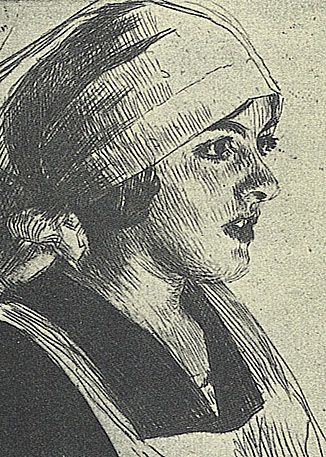
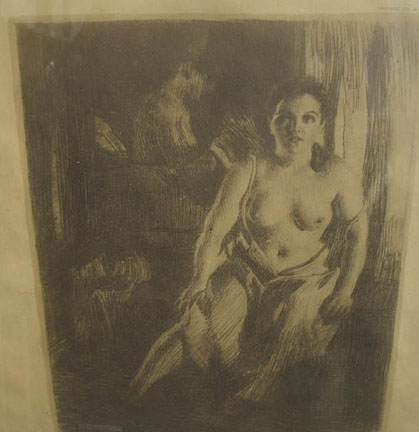

In September, Zorn returned to Mora and the 16 of October the Zorn's celebrated their wedding anniversary.
Zorn's graphic art was displayed during this year at Galleria Kometer in Hamburg at Leicesters Galleries in London, and at Keppel & Co in New York.
Most distinguished of the paintings from Mora were Gammal spegel, Gopsberget, Varafrg, Flodakulla (two variations) while the most noticeable of the pictures depicting the archipelago was Smalandska (also two variations). With the painting Sovande Modell Zorn whole- heartedly projects an image of the erotic female. Fredrik Martin reported from Florence on the Ides of March that Zorn's art had become raw during recent years.
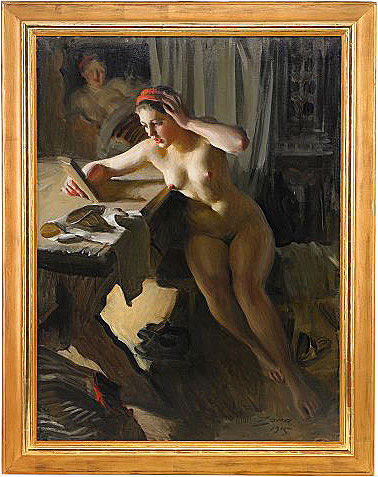
a

During the early summer, Zorn was in Mora and Gopsmor. He encouraged, according to the press, courses in master building by funding the attendee's trip to Leksand. During July and August Zorn made his yearly sailing trip with Mejt II and returned to Mora on September.
Later that year Zorn was an exhibitor with some watercolors at a charity exhibition in Uppsala with the motto Brod och Glod.
On the 11th of November a Swedish exhibit opened at Charlottenborg in Copenhagen, Zorn attracted attention and the critics Ernst Godschmidt who was not just being critical.
In February 1917 Omnibus was displayed, from Thorsten Laurin's collection at an exhibition arranged by Sveriges Allmanna Konstforening at Vasteras slott (Castle of Vasteras).
At the same time Bukowskis showed 5 new etchingss by Zorn, all from 1916: Byst, Mina Modeller, De Tva, Gopsmorstugan and Pa Hemso.
Zorn participated the same month in the festivities of the Bellman memorial at the Gyllene Freden (restaurant with fine old traditions) in Stockholm.
Prince Carl visited the Zorn Manor in the middle of March and they visited Folkhogskolan and Gammelgarden where Zorn made some work during the early spring.
The portrait of Clarence Von Rosen was presented at her 50th anniversary on the 12th of May and then towards the end of the month, Zorn was took part in the Student's Spring Festival.
In the early summer, he was in Mora and later he went on his yearly summer sailing. On the 29th of September Zorn made a donation to a children's home in Mora and it included the Wallinska garden in Morkarlby and, according to newspaper articles, the sum of 200,000 SEK. This was mentioned in The Chicago Daily Tribune on the 3rd of October, and on the 26th Zorn became an honorable member of Die K. K. Akademie der Bildenden Kunste in Vienna.
In the year of 1918, Zorn's physical fitness was not the best and the five- floor building with the staircases up to his studio was very painful for Zorn so he finally had to install an elevator. Now, finally the elevator arrived. The stairs were about to become a personal inferno.
For the benefit of the Swedish Red Cross, Zorn displayed 35 oil paintings housed in the Artists Association in Stockholm from February 18th to March 10th. The proceeds were 12,642 SEK and in response Zorn became permanent fellow at the Red Cross.
On May Zorn donated 20,000 SEK to Vastmanlands Dalanation in Uppsala and on the 30th of April he attended the Nations traditionella hogtidslandskap.
The 6th of June Zorn became Knight Commander of the Northern Pole Star order, first class.
On July, Zorn arranged things at the Gammelgarden and in one of the buildings, he found room for his relics of antiquity from Mora.
Later that summer he again made his usual yearly summer sailing trip and during the autumn he was working in his studio at Sodermalmstorg in Stockholm. Zorn spent a lot of time together with his friends Engstrom and Liljefors.
Zorn wrote to K. G. Westman 1919 about the death of Carl Larsson 22 of January. On the 18th of March Anders and Emma were making and signing their joint will. With the exception of some personnel legacy all of their property, both personal and estate, shall go to the Swedish State and be placed under the disposal of His Royal Majesty's Administration, and shall dispose of the inheritance without the Parliament's approval. The will also described how the Zorn Manor, Gammelgården and Gopsmor should stay intact. The collection was not to be moved and furthermore there was a requirement that a specific museum building be built of stone be erected at the Zorn Manor. From the Zorn's remaining fortune a fund should be established and its proceeds should be used for maintaining, nursing and the administration of the properties. The remainder of the estate shall be used for the benefit of Art and for the conservation of Nature and for the encouragement of culture historic interests. For the administration of the estate were appointed town councillor K G Westman and the lawyer Arvid Greber. Through this will, all former wills are revoked. And shall I Anders Zorn if I die and I am still the owner of the property No: 6 in the block Argus in Stockholm or part of it (Den Gyllene Freden) this shall go to Svenska Akademin in Stockholm according to this agreement made by me and banker G.A. Kyhlberger.
In consultation with K G Westman Zorn prepared for a bequest to the Swedish Academy- Bellman price. At the Art Academy's meeting 29th Zorn's and Herman Friedländer's donated 40,000 SEK to the Carl Larsson scholarship fund.
During April Zorn was sick and lay in bed in Mora, but in August he was back in Sandhamn for his summer sailing and this year Ols Maria was aboard.
The 12th of September when the executive committee for the Sweden-America foundation met it was announced to the chairman Svante Arrhenius that Zorn donated to the foundation 100,000 SEK to a travel scholarship for the Swedish citizens.
In December 52 etches by Zorn were exhibited in Edinburgh and towards the end of the year, Axel Tallberg's book about Zorn and his childhood, adolescence and school years was published (Minerva).
Zorn's mother died on the night of 7 January 1920 and Zorn arrived to Mora two days later. The funeral took place 10th of January and Anders wrote, not so cold, some snow fell. I went inside the log cabin and said goodbye to Mona (Mother), she was so alike grandmother, just younger.
During April Zorn and Liljefors were exhibitors at Liljevalchs konsthall. At the end of the exhibit, Zorn gave Diskerska as a gift to Centralforbundet for Sveriges Landstormsföreningar.
He donated (18 May, 150,000 SEK) meant for a professorship in art history at the Stockholm University. The first possessor of the professorship was Johnny Roosval. The deed of gift was permeated with a deep well- known ideology for education and Zorn observed that many and good forces devoted them self in the study of our nation's relics of art. He also considered that it was most important that the Swedish art research would have a firm and secured position at some of our universities. Zorn also expressed a wish that the possessor of the new professorship still had to work for that the ancient Nordic log building art was further researched, a domain that always had a particular place in my heart.
During the summer Zorn became more and more ill and was according to Ossbach tired and full of pain. After this summer's sailing and boozing in Sandhamn he was dead tired and returned to Mora. He had not been able to paint anything during this time.
Zorn needed emergency treatment and was hastily operated on at Mora hospital. The doctors could see suppuration with the accompanying blood poisoning in the lower abdomen.
Zorn died on Sunday the 22nd of August.
Zorn's funeral took place the 26th of August on a brilliant beautiful late summer day. In the papers you could read how the people in Mora and the prominent guests courteous gadded around the deceased and how simply the ritual was preceded. Archbishop Nathan Soderblom officiated at the funeral service without any funeral eulogy.
The Artists Association had always respected Zorn's artistic abilities. Not even the harsh Karl Nordström hesitated to speak well of his colleague, when he far away in Dordogne on 31th of August heard that Zorn was dead he wrote in he's diary:
The artistic soul that now is laid to sleep was of truly unusual measure. I think it is a little bit too much to say as G. Ankarcrona said that it takes measures that embrace the world. It's enough with little less and you still become impressed.
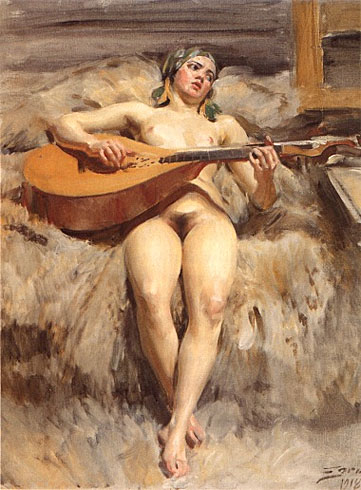
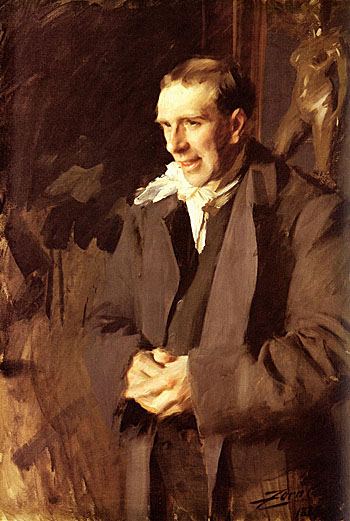
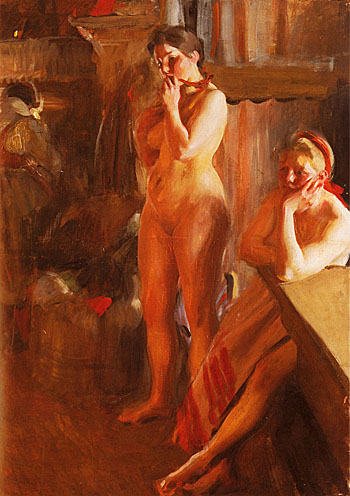
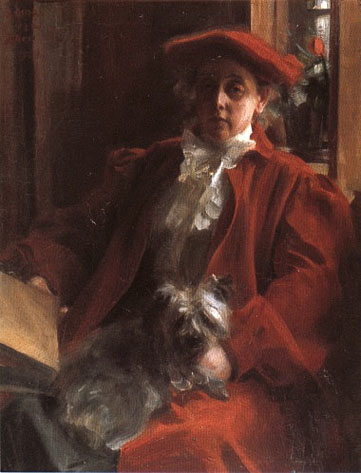



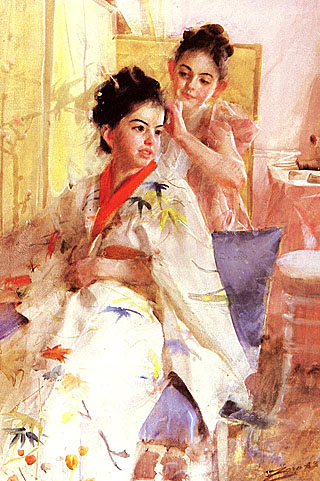
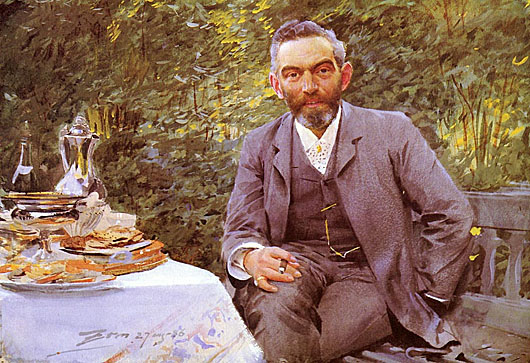
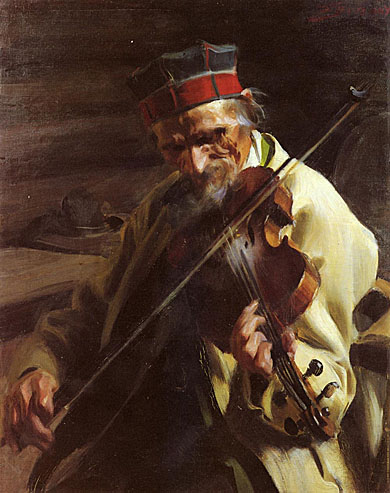
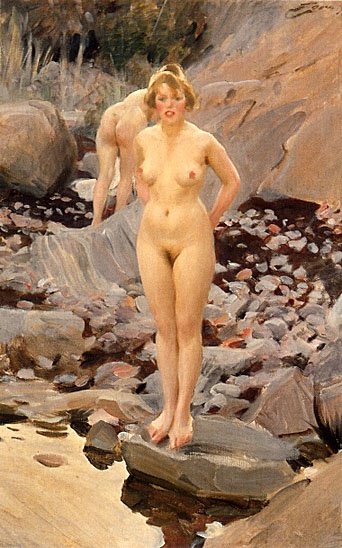



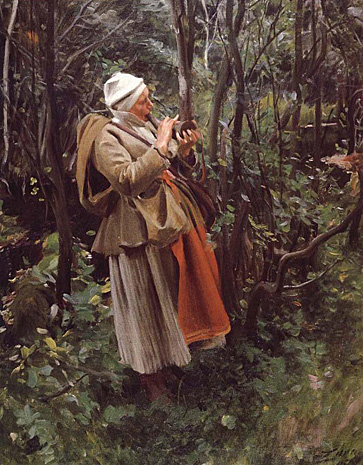


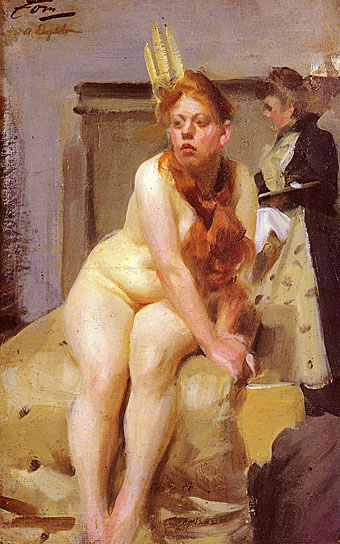
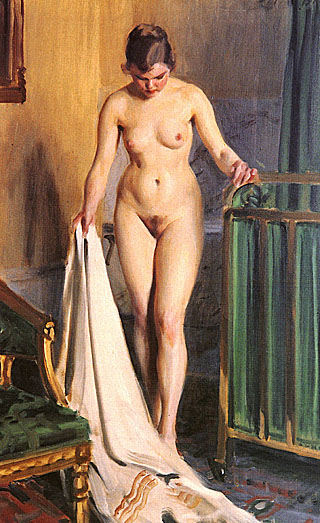
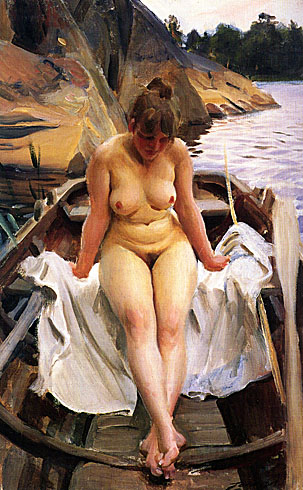

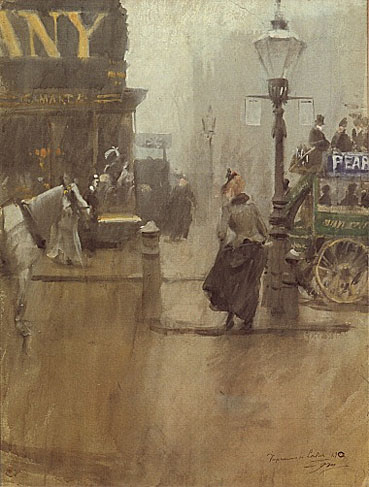


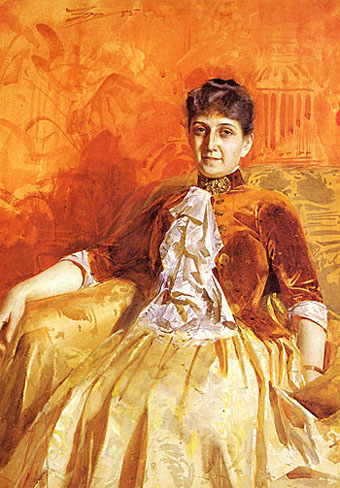
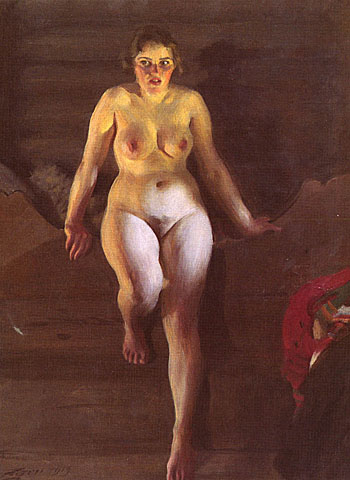


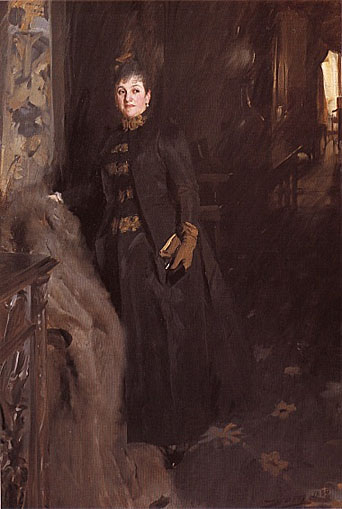
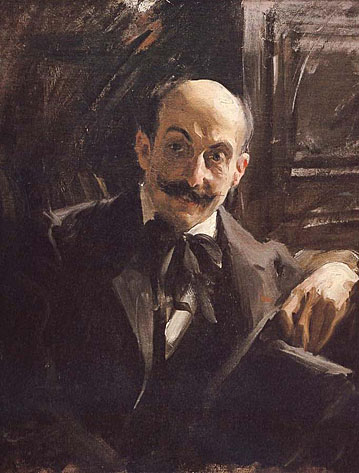

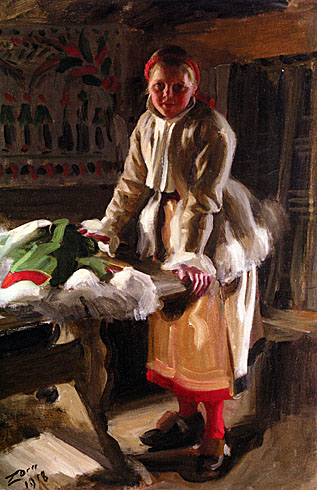
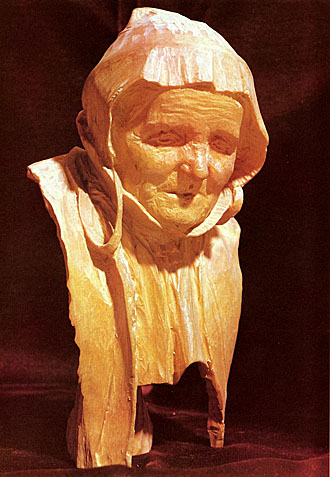

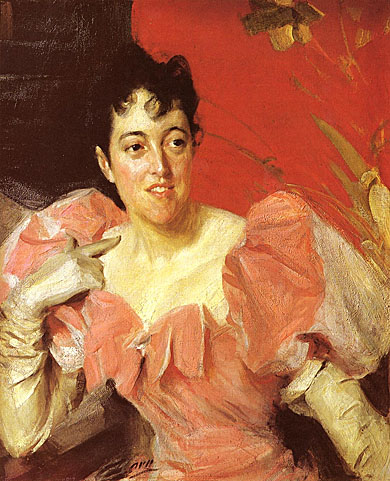

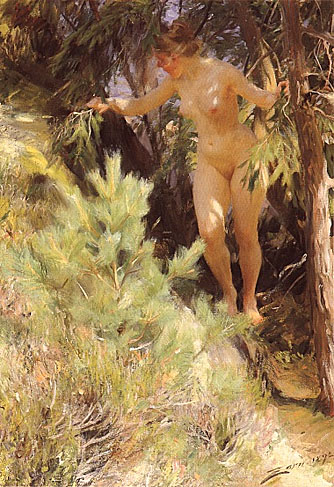
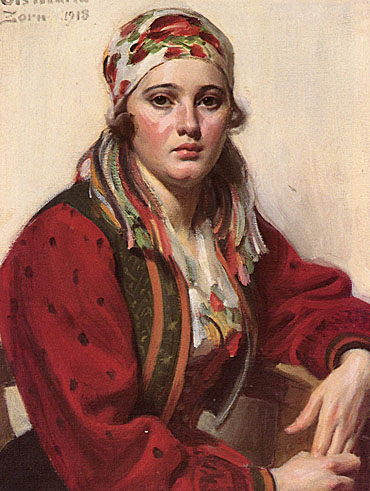

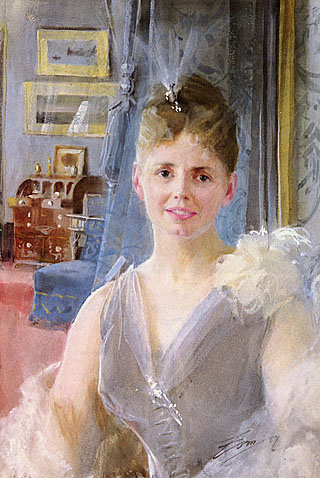
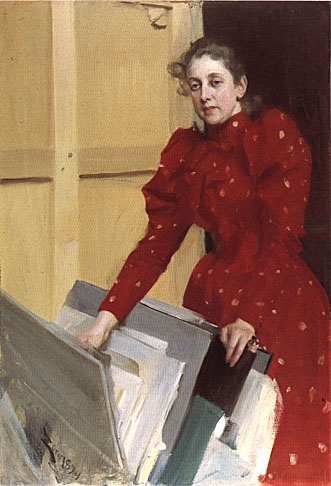

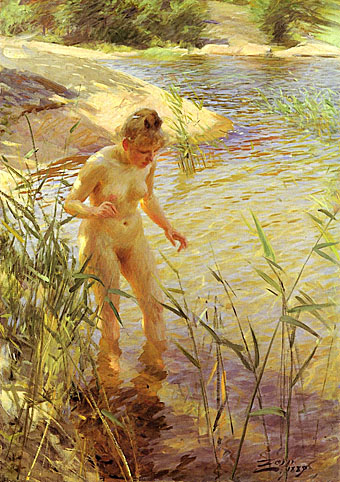
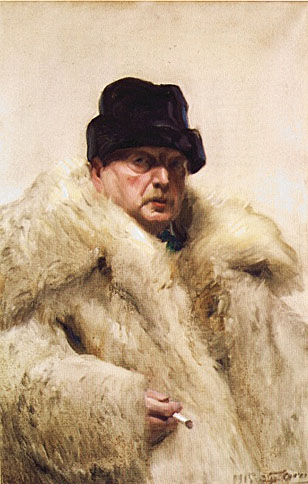
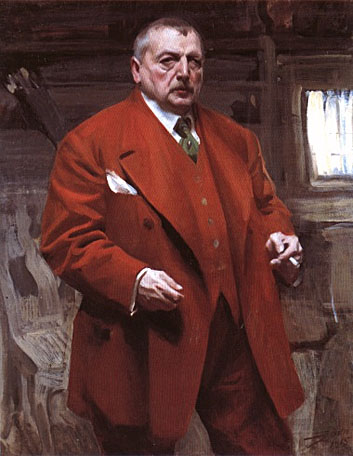
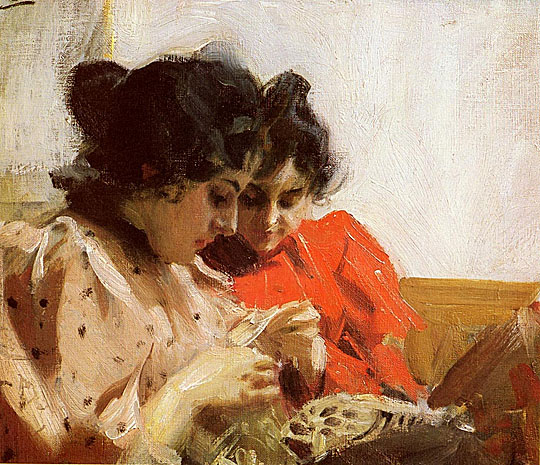


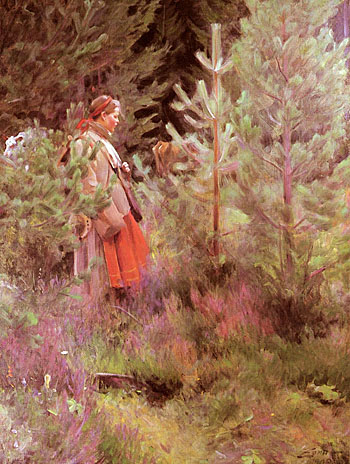




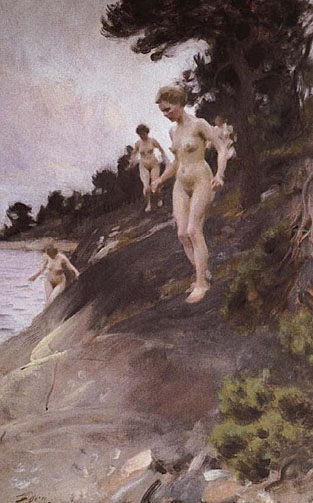

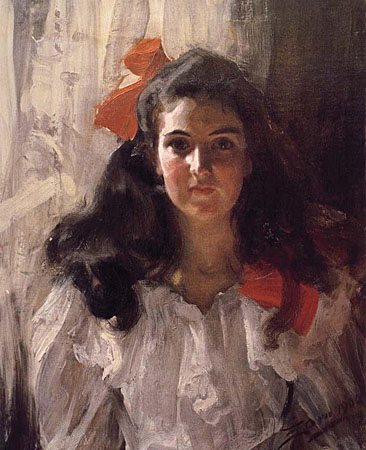

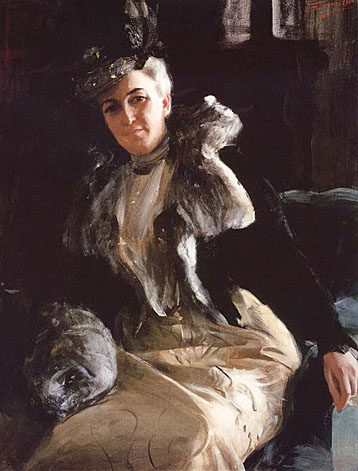
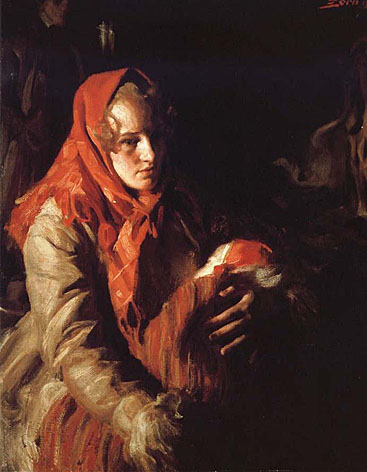
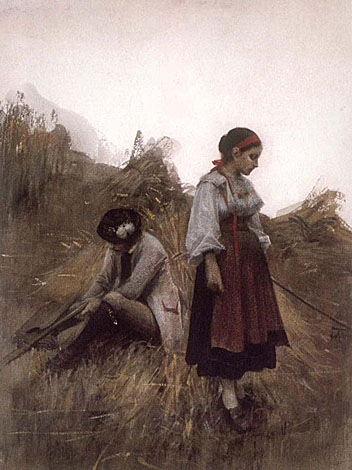
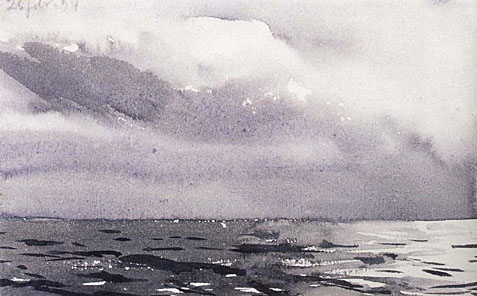



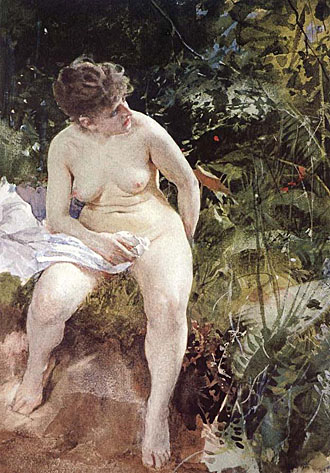
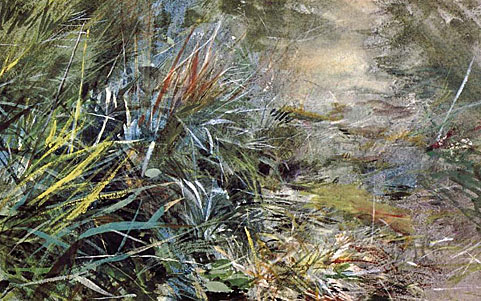


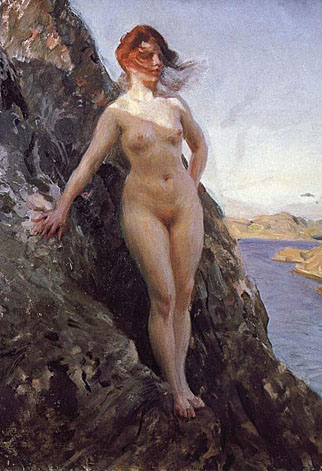

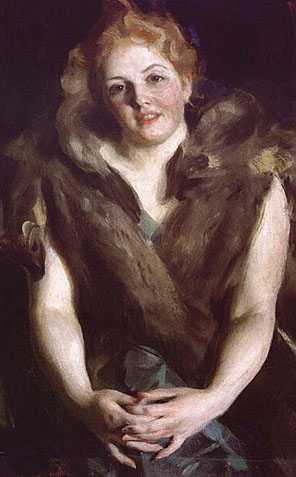
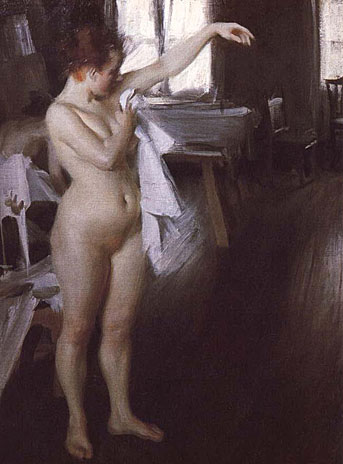

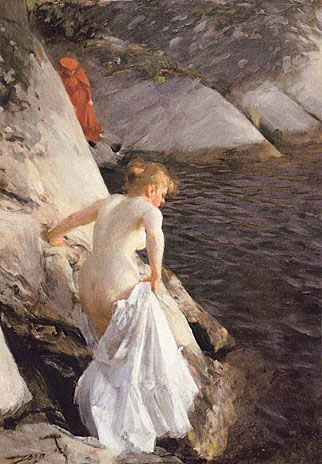

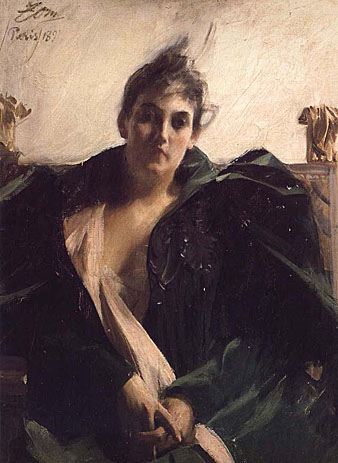
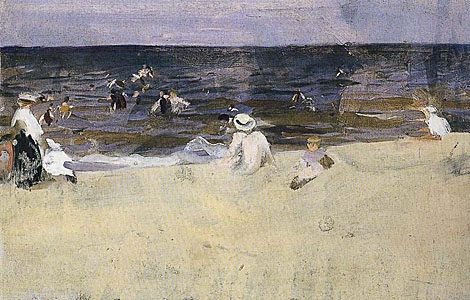
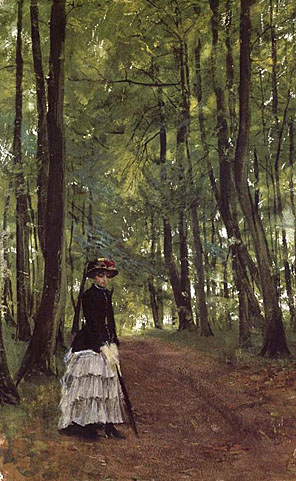

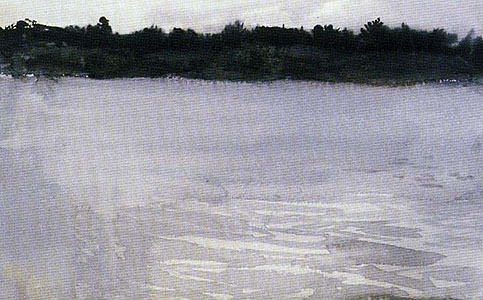
Source: Art Renewal Center
Return to Pagina Artis
Return to Bruce and Bobbie's Main Page.